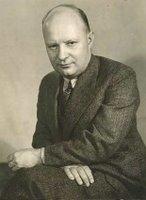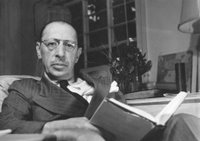20th-Century Opera at Tanglewood
The Festival of Contemporary Music commenced last night at the Tanglewood Music Center -- the "summer home" of the Boston Symphony Orchestra -- with a triple bill of one-act operas by 20th-century icons. The performance included Hindemith's 1927 absurdist comedy Hin und zurück (There and Back), Stravinsky's 1922 opéra buffe Mavra, and Elliott Carter's 1997 What Next?, which received its premiere American staging. All operas were performed in English. All performers and orchestra members, as well as the conductors for the Hindemith and Stravinsky operas, were fellows of the summer programs offered at Tanglewood. What Next? was conducted by James Levine. Hindemith's brief operas of the 1920s were intended to be a departure from everything related to opera as the world new it. Harmonic and rhythmic language, plot and development were all intended to be a shot in the arm of the status quo, and Hin und zurück is a perfect example of his aesthetic. The plot was simple: a man comes home to surprise his wife for her birthday. She receives a letter and, when pressed by the husband, reveals defiantly that it is from her lover. In a rage he kills her and then himself, all in front of an old deaf aunt who knits silently throughout the entire proceedings. But then a wise man appears, saying that life could just as easily proceed from death to birth. The action then reverses, phrase by phrase, back to the opening soprano aria "Now like new I awake."
Hindemith's brief operas of the 1920s were intended to be a departure from everything related to opera as the world new it. Harmonic and rhythmic language, plot and development were all intended to be a shot in the arm of the status quo, and Hin und zurück is a perfect example of his aesthetic. The plot was simple: a man comes home to surprise his wife for her birthday. She receives a letter and, when pressed by the husband, reveals defiantly that it is from her lover. In a rage he kills her and then himself, all in front of an old deaf aunt who knits silently throughout the entire proceedings. But then a wise man appears, saying that life could just as easily proceed from death to birth. The action then reverses, phrase by phrase, back to the opening soprano aria "Now like new I awake."
Orchestrated with pianos and winds the pungent harmonies that could have been written only by Hindemith were punched out in idiomatic 1920s jazz rhythms. Over this texture lay surprisingly graceful and beautiful tenor and soprano lines. Doug Fitch (who also has directed for, among others, Santa Fe Opera) directed and designed sets for all three productions. His treatment of the absurdist nature of the Hindemith was well realized in touches both subtle (the wise man springing forth and melting back into the wool of the aunt's knitting, a family photo springing to life on the last note right before the black out) and not (loud colors on the set, over-exaggerated melodramatic staging). The fully encompassing production was a gem and the highlight of the evening. In an interesting aside, there was a cameo appearance by legendary soprano Phyllis Curtin as the silent, knitting aunt. Stravinsky's Mavra did not fare as well in its translation - both to English and through Fitch's direction. The music is exquisite, straddling the line between Russian folk and Stravinksy's neoclassicism, and it took quite a while to recognize the signature style of the composer. The translation was wordy, and set the voices against the chamber orchestra texture, which became increasingly more complex as the story developed. Fitch's stage design - all straight lines and pastels - was washed out in Clifton Taylor's general lighting scheme.
Stravinsky's Mavra did not fare as well in its translation - both to English and through Fitch's direction. The music is exquisite, straddling the line between Russian folk and Stravinksy's neoclassicism, and it took quite a while to recognize the signature style of the composer. The translation was wordy, and set the voices against the chamber orchestra texture, which became increasingly more complex as the story developed. Fitch's stage design - all straight lines and pastels - was washed out in Clifton Taylor's general lighting scheme.
It also seemed that Fitch tried to link the Stravinsky with the Hindemith absurdist aesthetic, switching abruptly between stylized movements resembling that of cartoon characters and traditional Russian folk dance steps. The result, however seemed forced, especially as the plot of Mavra (a young girl gets her mother to hire a new maid, who actually is the girl's lover in disguise: hilarity ensues) could subsist on the inherent humor and didn't need to be adorned with cartoonish affectation. Unfortunately, all of the singers for the first two works were small-voiced, with the exception of tenor Randall Umstead, who played Vasily, the Hussar, in Mavra. The majority of the program's energy - better singers, more elaborate sets and fascinating lighting, not to mention the music direction of James Levine - went into the Carter opera What Next?. Without having a score in front of you, or having the time to pull everything asunder to see how it was put together, one can examine only the parts, but it is very difficult to delve deeply into the successfulness of the piece as a whole during one listening. The situation involves the aftermath of a multi-car accident, as indicated by the percussive "overture" and the grotesquely scattered remains of both cars and bodies as the curtain rises. The six characters spend the entire opera trying to figure out who they are, how they relate to each other (if at all), and what happened. It's not clear if they are deceased, though the ashen makeup and Catherine Zuber's costume design suggests so (black and shades of grey with dark red flowers adorning the head), as did Fitch's staging, which reflected the eerie, uncomfortable plot.
The majority of the program's energy - better singers, more elaborate sets and fascinating lighting, not to mention the music direction of James Levine - went into the Carter opera What Next?. Without having a score in front of you, or having the time to pull everything asunder to see how it was put together, one can examine only the parts, but it is very difficult to delve deeply into the successfulness of the piece as a whole during one listening. The situation involves the aftermath of a multi-car accident, as indicated by the percussive "overture" and the grotesquely scattered remains of both cars and bodies as the curtain rises. The six characters spend the entire opera trying to figure out who they are, how they relate to each other (if at all), and what happened. It's not clear if they are deceased, though the ashen makeup and Catherine Zuber's costume design suggests so (black and shades of grey with dark red flowers adorning the head), as did Fitch's staging, which reflected the eerie, uncomfortable plot.
| Available at Amazon: Elliott Carter, What Next?, Netherlands Radio Chamber Orchestra (released on November 25, 2003) |
An ECM recording of What Next? is available, a "review" (mostly interpretation) of which can be found here. The Festival continues through July 31, and Tanglewood's offerings continue through early September.





















































No comments:
Post a Comment